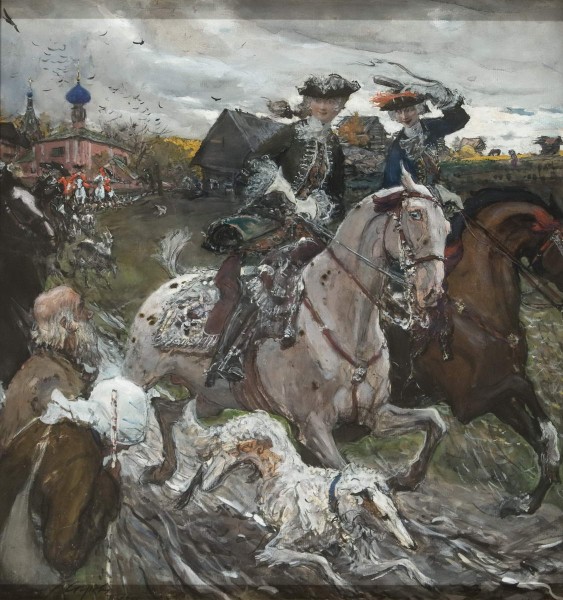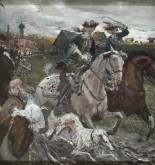Peter II and Princess Elizabeth Riding to Hounds
Иллюстрации к изданию: Кутепов Н. И. Царская и императорская охота. Конец XVII и XVIII век: В 4 т. СПб, 1896–1911. 1900–1902. 1900
- Paper mounted on cardboard, tempera, gouache. 41 x 39
- Ж-4291
Received in 1912-
Сведения о реставрации:
Реставрация: Щукина Е. Ю. (1992)
- Period Late 19th century – Early 20th century
- CategoryHistory Painting
- Share
In the middle of the eighteenth century, the period of Rococo, the different forms of hunting which had been popular in Russia since ancient times acquired a ritual and spectacular character. The elegant Tsarist horsemen, inflamed by high-spirited conversation and the imminent hunt, ride purposefully past the half-destroyed village and the poverty stricken villagers, accompanied by a splendid cortege of courtiers. By juxtaposing two Russias, the aristocratic Russia, in step with Europe, and the peasant Russia, dark and denied all rights, Serov exposes the source of the insurmountable contradictions of Russian life. Play and Passion in Russian Fine Art. St-Petersburg. 1999. P. 304.
Designed to illustrate Nikolai Kutepov’s book Tsarist and Imperial Hunting, Valentin Serov’s work reflects the new understanding of history painting at the turn of the century. Serov and the other members of the World of Art preferred poetic images of daily life in the «golden age» of the eighteenth century to the more important historical events. The artist depicted historical themes in order to reflect on the fate of his country. He depicts a dashing cavalcade consisting of the fourteen year-old Tsar Peter II (1727–30) and Princess Elizabeth, daughter of Peter the Great, against a background of rickety huts and down-at-heel peasants. Dynamic, poignant and piquant, Peter II and Princess Elizabeth Riding to Hounds offers an excellent example of Serov’s painterly mastery. The rustic landscape in autumn makes an important contribution to the artistic image. Russian Museum: From Icons to the Modern Times. Palace Editions, St Petersburg, 2015. P. 228.

